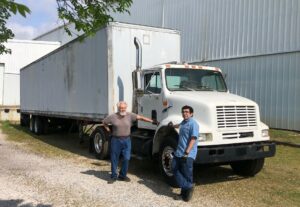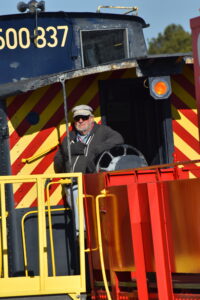Join the team at the Southeastern Railway Museum

Most of the people you see working at the Museum are volunteers. They average around 260 total hours a week! That’s a strong testament to the opportunities and to the people who share their skills.
Ever wonder what it takes to run a locomotive, staff a gift shop or drive a park train? Do you enjoy working with children on educational programs? Perhaps you prefer something in the background – like working on fundraisers or helping design and build exhibits?
No matter what your interest or skills, the Southeastern Railway Museum offers fulfilling opportunities to get involved. Our dedicated volunteers bring transportation history to life, helping visitors appreciate and understand the cultural, technical, and economic impact of transportation in our region – and they have fun doing it!
Did You Know?
- Museum volunteers come from a wide range of backgrounds – pros to students . . .
- Our volunteers range in age from high school students to retirees.
- About a quarter of our volunteers are women, who work in every phase of Museum operations.
- A typical volunteer gives about 16 hours a month; volunteer managers work as much as 80 hours each month
- Volunteers provide almost 14,000 hours of service each year – a level of service that has been increasing each year
Areas of Interest
- Historic train crew
- Restorations of equipment
- Gift shop
- Park train crew
- Party managers
- Track maintenance
- Exhibit construction, maintenance, & repair
- Landscape design & maintenance
- Event planning & hosting
- Holiday activities
- Seasonal events
- Group tour guide
- Computer skills (networking, website maintenance…)
- Your interest and expertise here…
Volunteer FAQs
Q. What is the museum’s mission?
A. The mission of the Southeastern Railway Museum is to provide an educational atmosphere that vividly brings to life the cultural, technological, and historical importance of transportation to our region.
Q. Do I have to have experience with trains to volunteer?
A. While some of our volunteers have experience in the rail industry, most do not. An interest in the Museum’s mission and a commitment to work are all that is needed.
Q. Will my skills be useful?
A. Certainly. The museum relies on volunteers in every aspect of our work, ranging from restoring locomotives or rolling stock to teaching children or answering the phones. Whatever your skills, chances are that we need them and you.
Q. What if I’m not comfortable with kids?
A. We do have a lot of programs that focus on kids and their families, but that’s only part of what we do. If you aren’t comfortable working with children, you can still easily find a place at the Museum. We have plenty of adults to work with, too!
Q. Do I have to be a member to volunteer?
A. Not at all. We encourage everyone who likes the Museum to become a member but understand that not everyone can. Volunteering is a great way to support the Museum, whether you’re a member or not.
Q. I have physical or mobility limitations. Can I still volunteer?
A. Absolutely! The main buildings are all accessible, and we’ll be happy to work with you to find a role you can enjoy. Some work areas may be out of reach – but if you want to volunteer, there’s a job that’s just right for you!
Q. Will I need to pass a background check?
A. All volunteers and employees at the museum must complete a free, confidential background check.
Q. Do I have to buy my own uniform?
A. Volunteers in public-contact positions (like docents, education program aides, and train crew members) are required to wear appropriate clothing, usually a Museum shirt and name badge. You earn additional shirts as you build up volunteer hours.
Becoming a Volunteer
Interested in becoming a Southeastern Railway Museum volunteer? Here’s how:
Apply
The first step is to fill out an application, Volunteer with the Southeastern Railway Museum.
Interview
After reviewing your application, our Volunteer Coordinator will set up a campus tour with you to discuss current volunteer opportunities, explore your areas of interest, and determine whether your interests and skills match an available position. Placements are based on both volunteer interests and Museum needs.
Orientation
Once you’ve found your perfect volunteer opportunity, our Volunteer Coordinator will introduce you to Museum policies and practices relevant to your area of responsibility. These guidelines are intended to ensure that volunteers and guests alike enjoy a safe and educational environment.
Please Note
Applicants should be 18 years of age or older. Younger volunteers are welcome but must be accompanied by a parent, legal guardian, or Museum-approved supervisor while on site.
We track volunteer hours for grant support.

